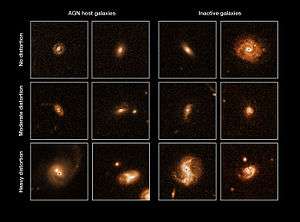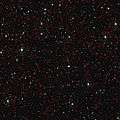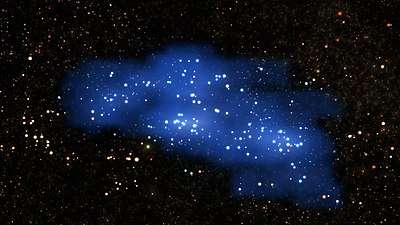Cosmic Evolution Survey
The Cosmic Evolution Survey (COSMOS) is a Hubble Space Telescope (HST) Treasury Project to survey a two square degree equatorial field with the Advanced Camera for Surveys (ACS).[1] The largest survey ever undertaken by HST, the project incorporates commitments from observatories around the world, such as the Very Large Array radio observatory, the European Space Agency's XMM-Newton satellite, and Japan's eight meter Subaru telescope. At the moment, more than 150 astronomers around the world actively contribute to the project.
| Members | more than 200 (as of 2019) |
|---|---|
| Website | http://cosmos.astro.caltech.edu |

The project's primary goal is to study the relationship between large scale structure (LSS) in the universe and dark matter, the formation of galaxies, and nuclear activity in galaxies. This includes careful analysis of the dependence of galaxy evolution on environment.[2]
The survey covers a field, often known as the COSMOS field, of 2 square degrees of sky in the constellation Sextans. The centre of the field in j2000 coordinates is at Right Ascension 10:00:24 Declination 02:10:55
Gallery
 Sample of non-star-forming galaxies from the COSMOS survey.[3]
Sample of non-star-forming galaxies from the COSMOS survey.[3] COSMOS field in the constellation of Sextans.[4]
COSMOS field in the constellation of Sextans.[4] COSMOS survey combines data from ESO’s Very Large Telescope and ESA’s XMM-Newton X-ray space observatory.[5]
COSMOS survey combines data from ESO’s Very Large Telescope and ESA’s XMM-Newton X-ray space observatory.[5] Visualization of the Hyperion proto-supercluster found within COSMOS.[6]
Visualization of the Hyperion proto-supercluster found within COSMOS.[6]
References
- Scoville, N.; Aussel, H.; Brusa, M.; Capak, P.; Carollo, C. M.; Elvis, M.; Giavalisco, M.; Guzzo, L.; Hasinger, G.; Impey, C.; Kneib, J. ‐P.; Lefevre, O.; Lilly, S. J.; Mobasher, B.; Renzini, A.; Rich, R. M.; Sanders, D. B.; Schinnerer, E.; Schminovich, D.; Shopbell, P.; Taniguchi, Y.; Tyson, N. D. (2007). "The Cosmic Evolution Survey (COSMOS): Overview". The Astrophysical Journal Supplement Series. 172: 1. arXiv:astro-ph/0612305. Bibcode:2007ApJS..172....1S. doi:10.1086/516585.
- "COSMOS". Cosmic Evolution Survey. Retrieved 19 October 2015.
- "When galaxies switch off". ESA/Hubble Press Release. Retrieved 14 August 2013.
- "VISTA Stares Deep into the Cosmos". ESO Press Release. Retrieved 21 March 2012.
- "What Activates a Supermassive Black Hole?". ESO Science Release. ESO. Retrieved 13 July 2011.
- Largest Galaxy Proto-Supercluster Found - Astronomers using ESO's Very Large Telescope uncover a cosmic titan lurking in the early Universe, European Southern Observatory (ESO), 17 October 2018, Science Release eso1833, retrieved 19 October 2018